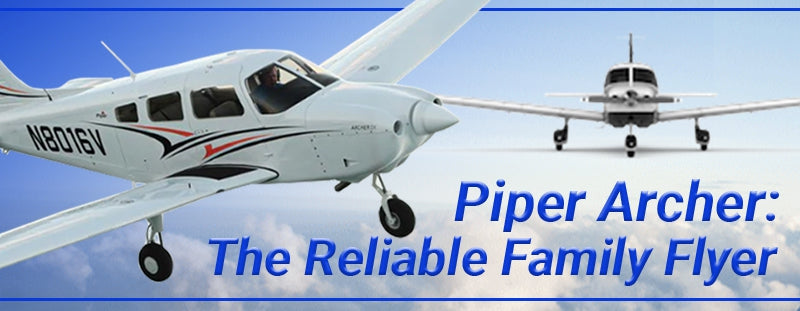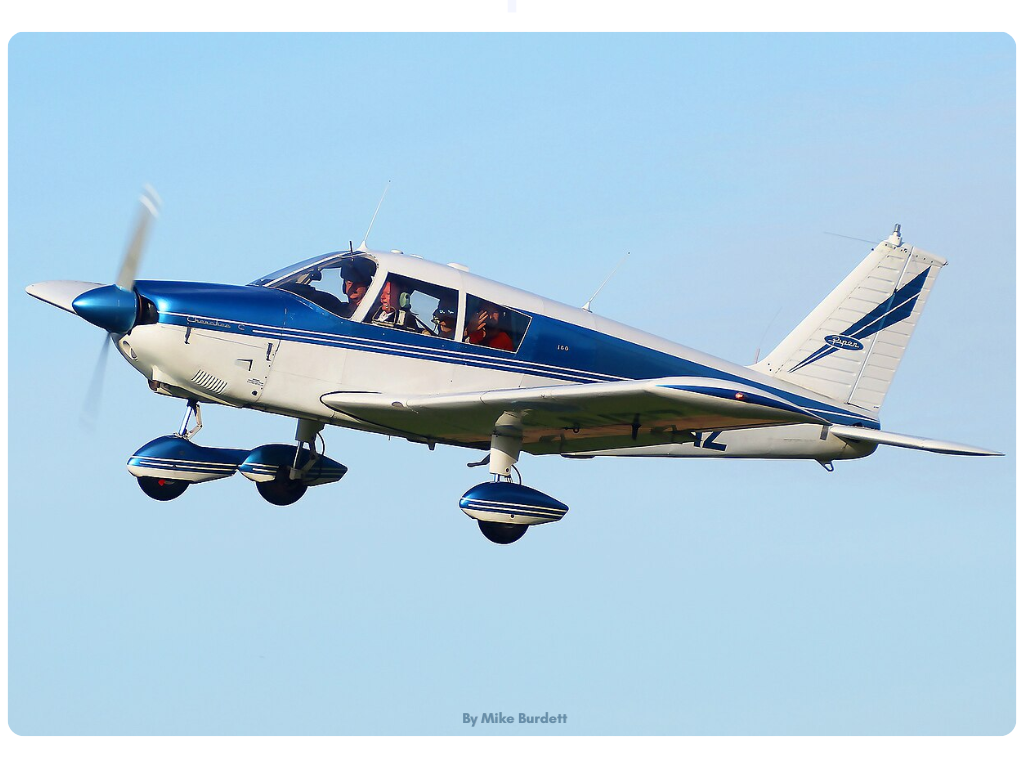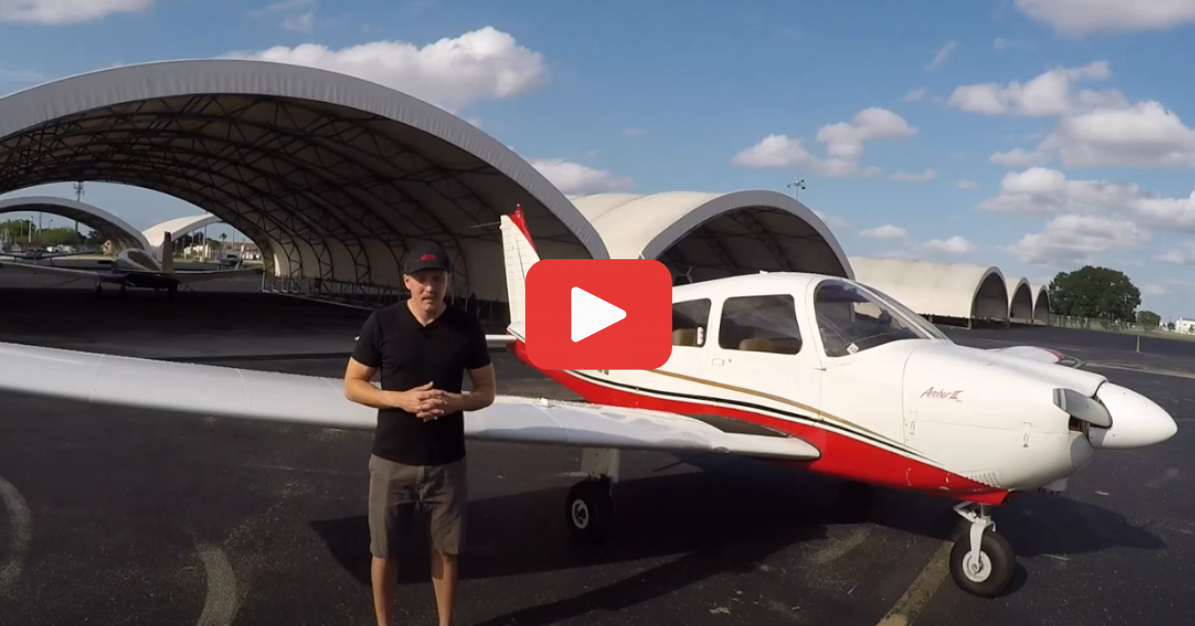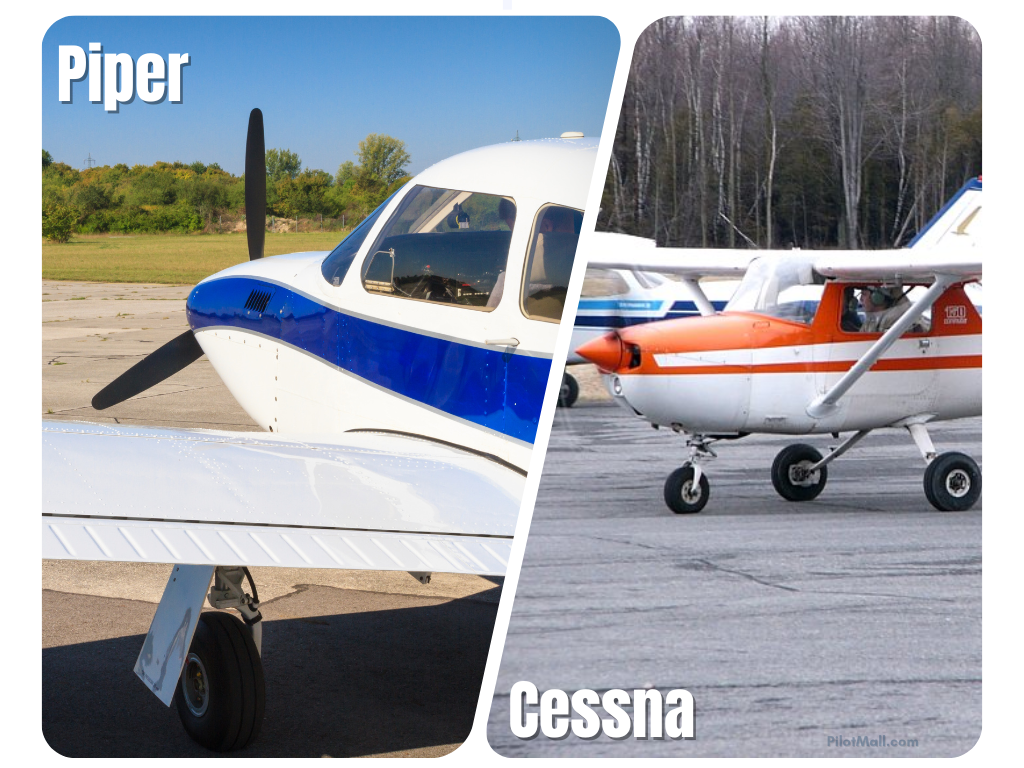Piper Archer: The Reliable Family Flyer

Featured Pilot Gear
Browse our selection of high-quality pilot supplies! Your purchase directly supports our small business and helps us continue sharing valuable aviation content.
The four-place Piper Archer, also known as a Cherokee 180 or PA-28-180, is a single-engine low wing, tricycle gear utility plane known for its stable, predictable, and forgiving flight handling characteristics.
The Archer is a favorite for individual owners wanting a solid, affordable four-place aircraft that flies as easily as a trainer yet has upgraded options available.
More than 32,000 PA-28 series aircraft have been produced since the original Cherokee debuted in 1960, and several models are still in production today.
Should your next aircraft be a Piper Archer? Here’s what you need to know so you can decide.
Table of Contents
- Origin of the Piper Archer
- Designing the Piper Archer
- Flying the Piper Archer
- Is the Piper Archer Safe?
- Purchasing a Piper Archer
- Variants of the Piper Archer
- Piper Archer vs Cessna 172
- 1998 Piper Archer III PA-28 Specifications
- 2020 Piper Archer LX Specifications
- Already a Piper Archer Owner?
- Frequently Asked Questions
Origin of the Piper Archer
The family of aircraft which includes the Piper Archer, Piper Warrior, Piper Arrow, Piper Cherokee, Piper Dakota, Piper Cadet, and Piper Pilot variants is also collectively referred to as the “Piper PA-28” or “Piper Cherokee” since all these aircraft were based off the original Piper PA-28-150 and PA-28-160 Cherokee designs circa 1961.
The PA-28 family was designed to replace the PA-22 Tri-Pacer and Colt models. The goal was to develop a low-cost modern Piper plane that could directly compete with the Cessna 172 both as a trainer and budget-friendly family aircraft. The resulting PA-28 design with its low-wing aluminum monocoque construction was a significant departure from the high-wing fabric-covered PA-22s.
Designing the Piper Archer
As part of the Piper Cherokee family, the Piper Archer design which debuted in 1974 was not clean sheet. It was based on the existing specs of the successful original Cherokee design by Fred Weick, John Thorp, and Karl Bergey. Weick is also the designer of the Ercoupe.
Due to the similarities between the Cherokee and Archer, people often ask, “What is the difference between a Piper Archer and Cherokee?” This question is understandable, especially given that the original Piper Archer also shares the PA-28-180 designator with the Cherokee.
Much of the potential confusion stems from the naming convention. The Cherokee 180 first was renamed the Challenger in 1973 before being rechristened the Archer in 1974. The name “Cherokee” is now used to reference the entire family of related airframes.
Tapered Wings (Starting with the Archer II)
The original Piper Cherokee design took to the skies sporting Piper’s Hershey Bar wing, but in 1974 Piper debuted a semi-tapered wing design on the Archer II. The goal of the redesign was to improve stall characteristics and crosswind handling, although there is still an ongoing Hershey bar vs tapered wing debate.
Some even say the driving force behind the re-design was merely to improve aesthetics for competition with the Cessna 172. Notably, John Thorp, one of the Cherokee co-designers went on record to criticize the new wing design saying it tended to stall outboard, thereby reducing aileron effectiveness and increasing spin potential.
Go ahead and weigh in. In the comments tell us which wing style you prefer and why.
Flying the Piper Archer
After flight testing a Piper Archer, pilots generally conclude that planes in this series are solid all-around good aircraft. No plane is perfect, but the Archer is consistent on all counts with performance and handling you can depend on regardless of the situation. Handling quirks are virtually non-existent on this aircraft, and the flight controls are well balanced across all axes.
The Archer’s stable and forgiving flight handling characteristics coupled with the tricycle landing gear configuration, are selling points for novice pilots.
Stalls are very gentle regardless of flap configuration and you receive plenty of advance stall warning through airframe buffet. When the Archer finally does stall, you won’t find yourself fighting any of the wing drop tendencies some other aircraft are prone to.
Pilots coming over from an electronic flap aircraft will notice a difference with the Archer’s manual wing flaps. The manual flaps deploy quickly and smoothly, even in the case of electrical failure (an added safety bonus). Just remember to keep forward pressure on the yoke, as flap deployment results in an upward pitching moment.
Is the Piper Archer Safe?
The Piper Archer is a safe aircraft, however it has one structural anomaly you should monitor for. Multiple Archer planes have sustained wing spar cracks.
In a few instances the cracking caused the wing to break off mid-flight leading to fatalities. Review airworthiness directives and confirm the inspection/repair status of Archer aircraft before you purchase one.
Purchasing a Piper Archer
Speaking of purchasing, how much does a Piper Archer cost? According to Aircraft Cost Calculator, the average current sale price for a pre-owned Piper Archer LX aircraft is $285,000. Muncie Aviation Company lists a base price of $369,770 for a 2019 Archer LX. Meanwhile, an Archer III costs about $188,950.
The reliable Lycoming O-360 series engine and simple systems make for an easy to repair, low maintenance required aircraft. Parts are readily available and nearly any aviation mechanic can work on an Archer, so you won’t need to bring in a specialist.
You can even complete some DIY work on your Archer, as many pilots in the Piper Flyer Association do. Just be sure you are following FAA policies for owner maintenance and repair.
Insurance costs are typically on the average to lower end of the spectrum with no additional hoops to jump through since the Archer is known to be a straightforward, safe, easy to pilot aircraft.
All these factors mean your Piper Archer purchase comes with reasonable operational and ownership costs to help you stay on budget long-term.
Variants of the Piper Archer
The Archer’s overall design is timeless and has changed very little over its decades of production. A 2022 Archer will look quite similar to a mid-90’s model and even bare a marked resemblance to late-70’s era planes.
Still, there are certainly a few nuances to compare when choosing which Piper Archer variant is right for you.
Archer
The original 1974 Piper Archer shared the PA-28-180 designation of the Cherokee design it sprang from. The Archer kept the all-metal body, low-wing configuration, and tricycle landing gear of the original Cherokee; however, the Archer was designed to be 5-inches longer than the 180 Cherokee. Most of the additional aircraft length provided welcome extra leg room for passengers in the rear seats.
The 1974 Archer also sported a bigger stabilator and longer (though still constant chord) wings. These modifications came with an increased gross weight.
Archer II
The Piper Archer II, re-designated PA-28-181 debuted in 1976. With this model, Piper traded out its original Hershey-bar wing for a longer, semi-tapered design. The new wing configuration was chosen largely to provide improved stall characteristics, though it also boosted cruise speed slightly.
Archer III
The Archer III was released in 1994, debuting a host of aesthetic design updates. The cockpit of the Archer III was outfitted with substantial new yokes, an upgraded instrument panel, overhead control switches, and a more muted color palette.
Functionality was also improved. The landing and taxi lights were moved to the wing tips to decrease the vibration induced filament breaking issues found on the Archer II.
The electrical system for the instrument panel was upgraded from 14-volts to 28-volts to support more high-draw electronic accessories and air conditioning.
Archer LX
The Piper Archer LX was introduced in 2010 and is still in production today. Piper describes this aircraft as “an elegant and reliable aircraft” that is “the perfect plane for both experienced and newer pilots.”
Archer DLX
The Piper Archer DLX was released in 2014, and according to Piper, this plane is designed for “efficient, luxurious, comfortable and safe personal flying.” It is a frequent flyer aircraft “perfect for the city-hopper and the recreational pilot alike.”
Archer TX
Piper hasn’t forgotten about supporting student pilots. The current TX version of the Archer offers an ideal training platform with “the perfect combination of durability, reliability, comfort and technology.”
The TX is designed to support the training needs of students at a purchase and operating cost price point that flight schools can afford.
Piper Archer vs Cessna 172
The Cessna 172 is the Archer’s closest competitor. Both aircraft are dependable 4-place planes that are easy to fly for beginner pilots and those with more experience. The tricycle landing gear configurations are particularly forgiving for novices.
So, what is the difference between a Piper Archer and a Cessna 172? The Piper Archer vs Cessna 172 comparison begins with the most obvious visual difference: the Archer is a low-wing plane and the 172 is high-wing.
The high-wing vs low-wing aircraft debate is always a hot topic among pilots. For example, some prefer the clear, unobstructed ground view from a high-wing plane while others are willing to deal with decreased ground visibility in exchange for better overhead sky visibility and an unobstructed view when turning base to final. There are pros and cons to each design, and it ultimately comes down to personal preference and typical type of flight the plane will be used for.
Another key difference is manual flaps on the Archer and electric flaps on the 172. The manual flaps retract quicker, but the electric flaps can be more effective. Again, a matter of pilot’s preference.
When choosing between the Archer and the 172, if you frequently fly with passengers, also take note that while the Cessna 172 has a door on each side of the aircraft, the Piper Archer is designed with just a single door on the right side.
That said, the cabin of the Archer is wider, so once everyone gets inside and is seated, they will have more room to spread out.
1998 Piper Archer III PA-28 Specifications
- Engine: Lycoming O-360-A4M
- Horsepower: 180 hp
- Propeller: Sensenich 2 blade, fixed pitch
- Length: 24 feet
- Height: 7 feet 4 inches
- Wingspan: 35 feet 6 inches
- Wing Area: 170 square feet
- Wing Loading: 15 pounds/square foot
- Power Loading: 2 pounds/horsepower
- Seats: 4
- Standard Empty Weight: 1,683 pounds
- Maximum Gross Weight: 2,550 pounds
- Takeoff/Landing Weight: 2,550 pounds
- Maximum Useful Load: 875 pounds
- Baggage Capacity: 200 pounds
- Usable Fuel Capacity: 48 gallons
1998 Piper Archer III PA-28 Performance
- Takeoff Ground Roll: 1,135 feet
- Takeoff Over 50 ft. Obstacle: 1,610 feet
- Rate of Climb, Sea Level: 667 feet per minute
- Top Speed: 129 KCAS
- Cruise Speed: 128 KCAS
- Stall Speed (Landing Configuration): 46 knots
- Stall Speed (Clean): 51 knots
- Fuel Consumption: 10.5 gallons per hour at 75% power
- Endurance: 4.5 hrs
- Service Ceiling: 13,236 feet
- Landing Ground Roll: 920 feet
- Landing Over 50 ft. Obstacle: 1,400 feet
2020 Piper Archer LX Specifications
- Engine: Lycoming IO-360-B4A
- Horsepower: 180 hp
- Propeller: Sensenich 2-blade fixed pitch
- Length: 24 feet
- Height: 7 feet 3 inches
- Wingspan: 35 feet 6 inches
- Wing Area: 170 square feet
- Wing Loading: 15 pounds/square foot
- Power Loading: 14.2 pounds/horsepower
- Seats: 4
- Standard Empty Weight: 1,688 pounds
- Maximum Ramp Weight: 2,558 pounds
- Maximum Takeoff Weight: 2,550 pounds
- Maximum Useful Load: 870 pounds
- Usable Fuel Capacity: 48 gallons
- Baggage Capacity: 200 pounds
2020 Piper Archer LX Performance
- Takeoff Ground Roll: 1,135 feet
- Takeoff Over 50 ft. Obstacle: 1,608 feet
- Rate of Climb, Sea Level: 667 feet per minute
- Top Speed: 154 KCTAS
- Cruise Speed: 128 KTAS
- Stall Speed (Landing Configuration): 45 knots
- Stall Speed (Clean): 51 knots
- Fuel Consumption: 10.5 gallons per hour at 75% power
- Range: 522 nautical miles
- Service Ceiling: 14,100 feet
- Landing Ground Roll: 920 feet
- Landing Over 50 ft. Obstacle: 1,400 feet
Already a Piper Archer Owner?
We’d love to hear from you. In the comments, share how you chose to buy an Archer plus what you love and what you would change about the design. Any advice for would-be buyers?
No matter how long you’ve been flying, it’s impossible to memorize all the critical info about your aircraft. When seconds count in the cockpit, you need actionable information you can access fast.
Pick up an easy-to-read copy of the complete aviation checklist available for both the Archer II and Archer III. Normal and emergency procedures, Vspeeds, weight and balance, fuel capacity and more are all right at your fingertips with these highly valuable quick reference guides.
-
Piper Archer vs Cherokee - which is best?
Though this might confuse some, the Piper Archer and the Cherokee 180 are the same plane. You will hear some pilots call the aircraft the one name or the other.
-
What is the range of the Piper Archer?
The Piper Archer II has a range of 600NM, however, it's important to check the POH of any aircraft you fly for accurate specifications and try to consider those optimistic estimatations.
-
What is the easiest Piper to fly?
The Piper Cherokee 140 and the PA-38 are considered excellent entry level planes for new/student pilots.
-
How much does a Piper Archer cost?
This varies depending on the age, and maintenance history of the aircraft. A brand new Piper Archer can cost around $400,000-$520,000, where as an older used model can cost between $87,000-$300,000.
-
Are low-wing or high-wing aircraft better?
It's not possible to crown one aircraft wing configuration as the better of all the options. If it were that easy, then there'd only be one type of plane for sale. But no single wing setup is superior for any and every pilot and their flying objectives—each has its own pluses and minuses.
-
What is the difference between the Piper Archer, Arrow, Warrior and Cherokee?
A video by Pilot Mike on YouTube explains the answer to this best. In summary, the differences involve changes to the wing tampering, extra windows added, fuselage extensions, retractable landing gear, prop changes and engine power changes. In appearance they all share close similarities.
Want to learn how the Archer compares with other Piper planes?
Here are some posts to get you started:
Did you find this article helpful?
Do you think we missed anything important? Let us know in the comments below!


































